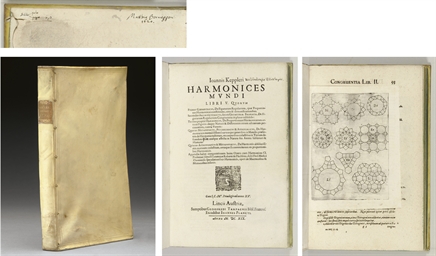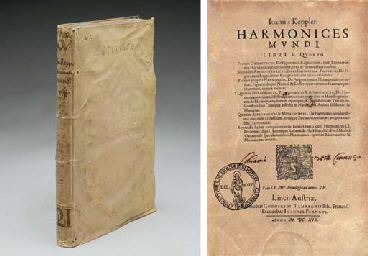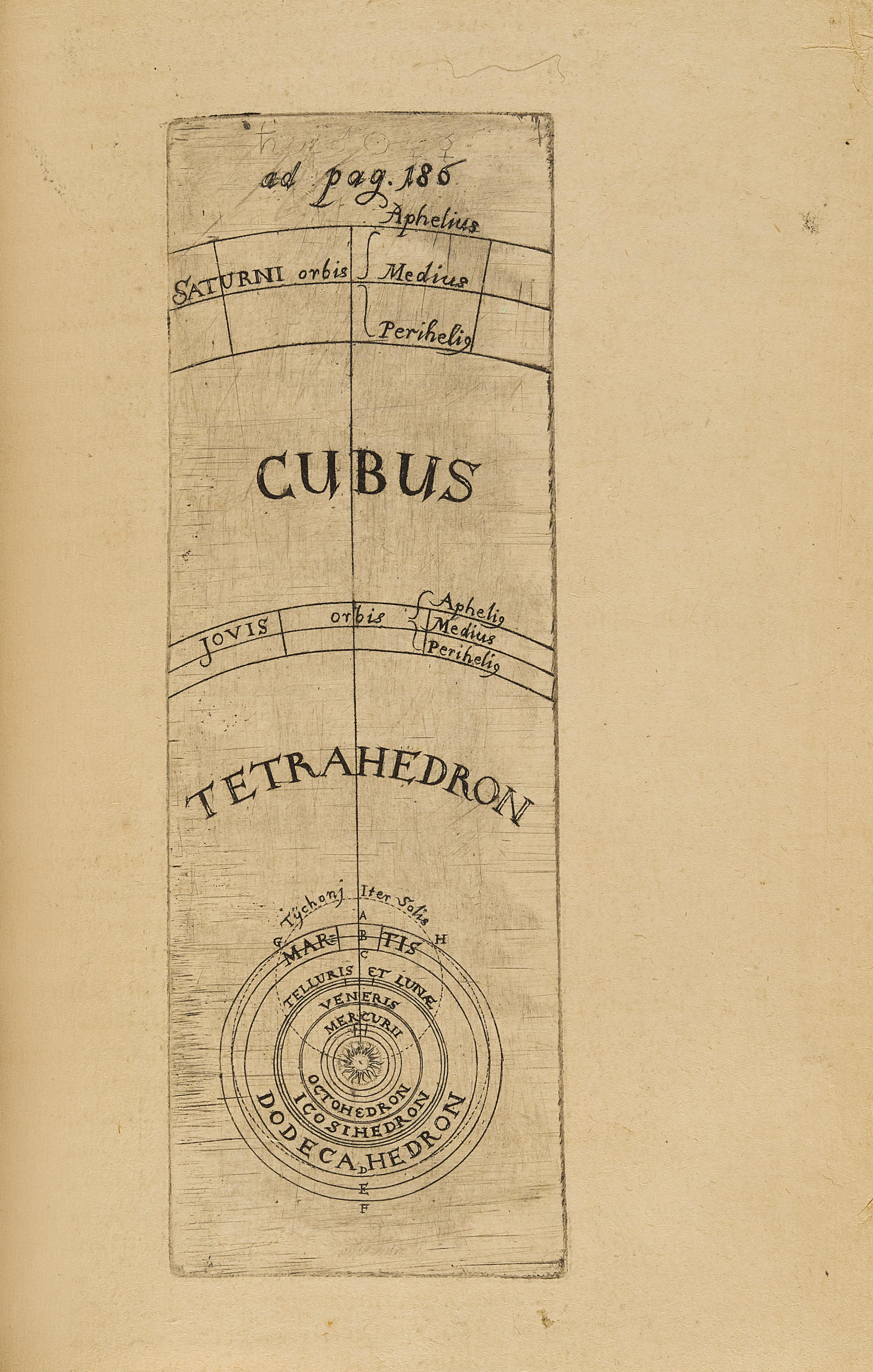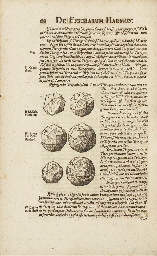KEPLER, Johannes (1571-1630). Harmonices mundi libri V . Linz: Johann Planck for Gottfried Tampach, 1619. [ Bound with :] -- Prodromus Dissertationum Cosmographicarum, continens Mysterium Cosmographicum de admirabili proportione orbium coelestium . [ And :] – Pro suo opere Harmonices Mundi Apologia . Frankfurt: Erasmus Kempfer for Godefrid Tampach, 1621-1622.
KEPLER, Johannes (1571-1630). Harmonices mundi libri V . Linz: Johann Planck for Gottfried Tampach, 1619. [ Bound with :] -- Prodromus Dissertationum Cosmographicarum, continens Mysterium Cosmographicum de admirabili proportione orbium coelestium . [ And :] – Pro suo opere Harmonices Mundi Apologia . Frankfurt: Erasmus Kempfer for Godefrid Tampach, 1621-1622. 3 parts in one volume, 2° ( Harmonices 325 x 205mm; Prodromus and Pro suo opere Harmonices 345 x 210mm). Harmonices : general title in second state with typographic ornament and with the text beginning 'Accessit nunc...,' 5 section titles, with the dedication to King James of England *2r-*4r (later suppressed by Kepler and absent from a few copies), errata leaf at end; 6 engraved plates, numerous woodcut diagrams and illustrations in text after W. Schickard, woodcut musical notation in Book III. (Title with marginal tear where stamp removed, but without loss, B3 with a minor marginal repair, light even browning throughout.) Mysterium Cosmographicum and Pro suo opere Harmonices : one folding engraved and 4 woodcut plates, woodcut diagrams. (Without final blank, closed marginal tear to F1, engraved folding plate with paper repairs to verso and mounted on a stub, very short tear in one woodcut plate near fold, light even browning throughout.) Modern binding of vellum-backed decorative boards, gilt spine, uncut. Provenance : evidence of removed stamps from title and final leaf of first work — Fr. Johannes ?Ere (washed 17th-century ink presentation inscription to Society of Jesus on final verso of third work, with ?associated woodcut crucifixion booklabel). FIRST EDITION OF KEPLER'S MAJOR COSMOLOGICAL TREATISE, BOUND WITH THE SECOND EDITION OF KEPLER'S MOST IMPORTANT WORK. When Kepler originally published Prodromus Dissertationum Cosmographicarum, continens Mysterium Cosmographicum as a defence against Fludd in 1596, it 'was the first unabashedly Copernican treatise since De Revolutionibus itself ... Kepler argued that the sun’s centrality was essential, for the sun itself must provide the driving force to keep the planets in motion ... although the principal idea of the Mysterium Cosmographicum was erroneous, Kepler established himself as the first, and until Descartes the only, scientist to demand physical explanations for celestial phenomena. Seldom in history has so wrong a book been so seminal in directing the future course of science’ (DSB). Three years later, Kepler was already at work on the Harmonices , an exposition of his theory of the harmony of the universe, and the work which describes the third law of planetary motion. However, his 1599 drafts were delayed by the grief that consumed him over the next few years with the death of two of his children. He sought solace in his work on the Harmonices , and all of his previous work and the insights into the working of the cosmos that he had gained in the intervening decades served as material for this, his life's work. 'Certainly for Kepler this book was his mind's favorite child. Those were the thoughts to which he clung during the trials of his life and which brought light to the darkness that surrounded him... his Harmonices appears as a great cosmic vision, woven out of science, poetry, philosophy, theology, mysticism...' (Caspar, p. 290, quoted in DSB). Kepler attempted to discern God's archetypal laws of the universe in four areas: geometry, music, astrology and astronomy. He conceived of a universal harmony as the embodiment of certain simple geometrical proportions relating these different aspects of the cosmos. In Book V, 'on the harmony of celestial motion,' Kepler refined the theory expounded in his Mysterium cosmographicum , and in the course of his investigations, 'Kepler hit upon the relation now called his third or harmonic law' (DSB). In this he related the magnitude of the planetary orbits to their periods of revolution around the sun, and established that the square of a planet's periodic time is pr
KEPLER, Johannes (1571-1630). Harmonices mundi libri V . Linz: Johann Planck for Gottfried Tampach, 1619. [ Bound with :] -- Prodromus Dissertationum Cosmographicarum, continens Mysterium Cosmographicum de admirabili proportione orbium coelestium . [ And :] – Pro suo opere Harmonices Mundi Apologia . Frankfurt: Erasmus Kempfer for Godefrid Tampach, 1621-1622.
KEPLER, Johannes (1571-1630). Harmonices mundi libri V . Linz: Johann Planck for Gottfried Tampach, 1619. [ Bound with :] -- Prodromus Dissertationum Cosmographicarum, continens Mysterium Cosmographicum de admirabili proportione orbium coelestium . [ And :] – Pro suo opere Harmonices Mundi Apologia . Frankfurt: Erasmus Kempfer for Godefrid Tampach, 1621-1622. 3 parts in one volume, 2° ( Harmonices 325 x 205mm; Prodromus and Pro suo opere Harmonices 345 x 210mm). Harmonices : general title in second state with typographic ornament and with the text beginning 'Accessit nunc...,' 5 section titles, with the dedication to King James of England *2r-*4r (later suppressed by Kepler and absent from a few copies), errata leaf at end; 6 engraved plates, numerous woodcut diagrams and illustrations in text after W. Schickard, woodcut musical notation in Book III. (Title with marginal tear where stamp removed, but without loss, B3 with a minor marginal repair, light even browning throughout.) Mysterium Cosmographicum and Pro suo opere Harmonices : one folding engraved and 4 woodcut plates, woodcut diagrams. (Without final blank, closed marginal tear to F1, engraved folding plate with paper repairs to verso and mounted on a stub, very short tear in one woodcut plate near fold, light even browning throughout.) Modern binding of vellum-backed decorative boards, gilt spine, uncut. Provenance : evidence of removed stamps from title and final leaf of first work — Fr. Johannes ?Ere (washed 17th-century ink presentation inscription to Society of Jesus on final verso of third work, with ?associated woodcut crucifixion booklabel). FIRST EDITION OF KEPLER'S MAJOR COSMOLOGICAL TREATISE, BOUND WITH THE SECOND EDITION OF KEPLER'S MOST IMPORTANT WORK. When Kepler originally published Prodromus Dissertationum Cosmographicarum, continens Mysterium Cosmographicum as a defence against Fludd in 1596, it 'was the first unabashedly Copernican treatise since De Revolutionibus itself ... Kepler argued that the sun’s centrality was essential, for the sun itself must provide the driving force to keep the planets in motion ... although the principal idea of the Mysterium Cosmographicum was erroneous, Kepler established himself as the first, and until Descartes the only, scientist to demand physical explanations for celestial phenomena. Seldom in history has so wrong a book been so seminal in directing the future course of science’ (DSB). Three years later, Kepler was already at work on the Harmonices , an exposition of his theory of the harmony of the universe, and the work which describes the third law of planetary motion. However, his 1599 drafts were delayed by the grief that consumed him over the next few years with the death of two of his children. He sought solace in his work on the Harmonices , and all of his previous work and the insights into the working of the cosmos that he had gained in the intervening decades served as material for this, his life's work. 'Certainly for Kepler this book was his mind's favorite child. Those were the thoughts to which he clung during the trials of his life and which brought light to the darkness that surrounded him... his Harmonices appears as a great cosmic vision, woven out of science, poetry, philosophy, theology, mysticism...' (Caspar, p. 290, quoted in DSB). Kepler attempted to discern God's archetypal laws of the universe in four areas: geometry, music, astrology and astronomy. He conceived of a universal harmony as the embodiment of certain simple geometrical proportions relating these different aspects of the cosmos. In Book V, 'on the harmony of celestial motion,' Kepler refined the theory expounded in his Mysterium cosmographicum , and in the course of his investigations, 'Kepler hit upon the relation now called his third or harmonic law' (DSB). In this he related the magnitude of the planetary orbits to their periods of revolution around the sun, and established that the square of a planet's periodic time is pr





.jpg?w=400)




.jpg)
.jpg)

.jpg)

Try LotSearch and its premium features for 7 days - without any costs!
Be notified automatically about new items in upcoming auctions.
Create an alert